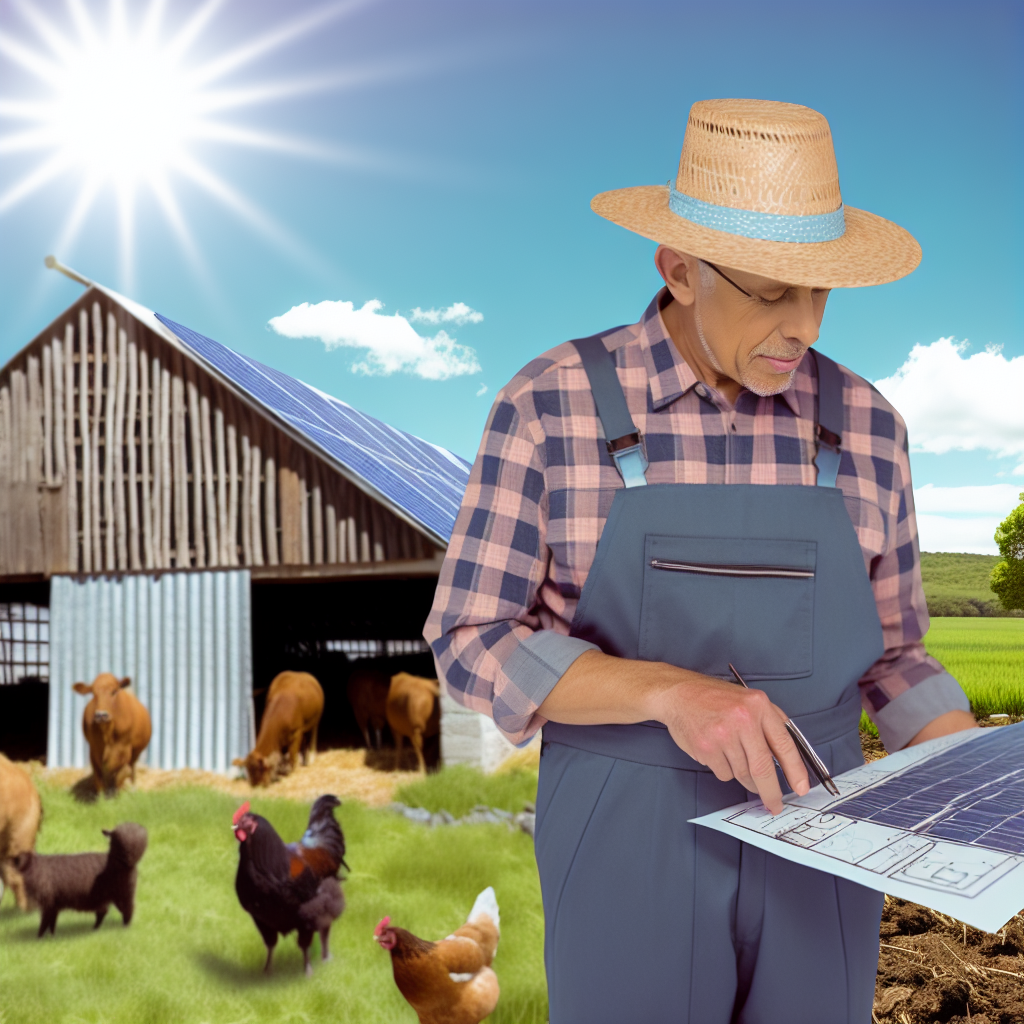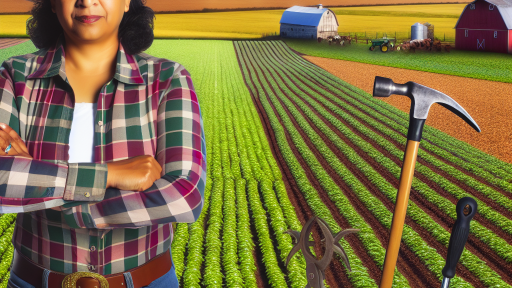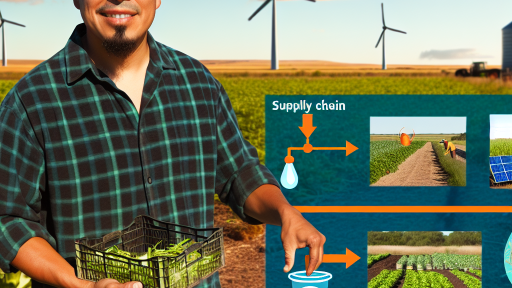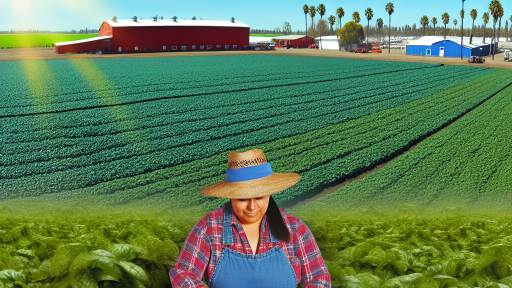Introduction to Sustainable Livestock Farming and Its Importance
Sustainable livestock farming is vital for environmental health.
This practice minimizes negative impacts on ecosystems.
Additionally, it supports animal welfare and biodiversity.
Farmers implementing sustainable practices also enhance food security.
They contribute to reducing greenhouse gas emissions in agriculture.
Benefits of Sustainable Practices
Sustainable livestock farming offers numerous benefits.
First, it conserves natural resources effectively.
Second, it improves soil health and fertility.
This leads to better crop yields over time.
Moreover, sustainable methods promote animal health and productivity.
Challenges to Implementation
Despite its benefits, challenges exist in implementing sustainable practices.
One significant challenge is the initial cost of transitioning.
Farmers often face financial burdens during this process.
Additionally, there may be a lack of knowledge about sustainable techniques.
Support from agricultural organizations can help address these issues.
Transform Your Agribusiness
Unlock your farm's potential with expert advice tailored to your needs. Get actionable steps that drive real results.
Get StartedCommunity and Global Impacts
Sustainable livestock farming positively impacts communities and the globe.
It fosters local economies through sustainable practices.
Moreover, it helps combat climate change effects on agriculture.
Consequently, it leads to stronger and more resilient food systems.
Overview of Environmental Impacts of Traditional Livestock Practices
Greenhouse Gas Emissions
Traditional livestock farming significantly contributes to greenhouse gas emissions.
For instance, methane from ruminants adds to the atmospheric burden.
Additionally, nitrous oxide from manure management exacerbates climate change.
Land Use and Deforestation
Livestock farming requires vast tracts of land for grazing.
This demand leads to deforestation in many regions worldwide.
Consequently, habitats for countless species are destroyed.
Furthermore, land conversion for feed crops increases pressure on ecosystems.
Water Usage and Pollution
Traditional livestock practices consume a significant amount of freshwater.
Water-intensive feed crops further strain water resources.
Moreover, runoff from manure often pollutes nearby waterways.
This pollution negatively impacts aquatic ecosystems and human health.
Soil Degradation
Overgrazing by livestock leads to soil erosion and degradation.
This process reduces soil fertility and agricultural productivity.
In the long term, it can lead to desertification in vulnerable areas.
Consequently, sustainable practices are essential for soil health.
Impact on Biodiversity
Traditional livestock farming threatens biodiversity on multiple fronts.
It leads to habitat loss, affecting numerous plant and animal species.
Additionally, monoculture feed cropping practices reduce genetic diversity.
This results in a less resilient agricultural system overall.
Principles of Sustainable Livestock Farming
Conservation of Natural Resources
Sustainable livestock farming prioritizes the conservation of natural resources.
Showcase Your Farming Business
Publish your professional farming services profile on our blog for a one-time fee of $200 and reach a dedicated audience of farmers and agribusiness owners.
Publish Your ProfileThis includes efficient water use and minimizing soil erosion.
Farmers must adopt practices that replenish soil health.
Crop rotation and cover cropping enhance soil fertility.
Animal Welfare Practices
Animal welfare is a core principle of sustainable livestock farming.
Farmers practice humane treatment and proper housing for livestock.
Access to outdoor space is essential for animal health.
Moreover, reducing stress for animals improves overall productivity.
Reduced Environmental Impact
Sustainable practices reduce the negative impact on the environment.
This involves managing manure effectively to prevent pollution.
Farmers can implement integrated pest management to minimize chemical use.
Overall, reducing greenhouse gas emissions is a vital goal.
Community Engagement and Support
Engaging with local communities supports sustainable practices.
Farmers can collaborate with local organizations for better resource sharing.
Education and outreach help raise awareness of sustainable practices.
Additionally, local sourcing strengthens community ties and economies.
Diversity in Livestock Breeds
Utilizing diverse livestock breeds enhances resilience.
This promotes biodiversity and prevents genetic vulnerabilities.
Farmers should select breeds adapted to local environments.
Furthermore, this diversity can lead to improved disease resistance.
Discover More: Comprehensive Tax Planning Strategies For Farmers And Agribusinesses
Integrating Crop and Livestock Systems for Improved Sustainability
Benefits of Integration
Integrating crop and livestock systems enhances sustainability on farms.
This approach promotes resource efficiency through symbiotic relationships.
Crop residues provide feed for livestock, reducing waste.
Meanwhile, animal manure enriches the soil for crops, promoting fertility.
Therefore, farmers can increase overall productivity and resilience.
Holistic Management Practices
Adopting holistic management practices improves integration outcomes.
This involves planning to optimize both crop and livestock production.
For instance, rotational grazing systems enhance pasture health.
Crops can be planted after livestock grazes, allowing for nutrient recycling.
Farmers like Sofia Green use these methods effectively on their farms.
Examples of Integration
Successful examples of integrated systems can be observed around the world.
In the U.S., mixed farming systems combine dairy and corn production.
Farmers utilize manure from dairy cows as fertilizer for cornfields.
This method lowers input costs while increasing yields.
Additionally, agroforestry integrates trees with livestock and crops, promoting biodiversity.
Challenges and Solutions
Challenges may arise when integrating crops and livestock.
Competition for resources such as land and water can be an issue.
However, proper planning and resource allocation can mitigate conflicts.
Utilizing cover crops also prevents soil erosion and enhances nutrient availability.
Community support and knowledge-sharing can greatly assist farmers.
Showcase Your Farming Business
Publish your professional farming services profile on our blog for a one-time fee of $200 and reach a dedicated audience of farmers and agribusiness owners.
Publish Your ProfileFuture of Integrated Practices
The future looks promising for integrated crop and livestock systems.
As demand for sustainable food sources grows, these practices will become crucial.
Farmers will likely adopt innovative technologies to improve efficiency.
Furthermore, education on sustainable practices can empower more farmers.
This integration will support not only farm profitability but also environmental health.
Find Out More: Choosing the Best Insurance for Your Farm
Best Practices for Pasture Management and Rotational Grazing
Understanding Pasture Management
Pasture management involves using land effectively for livestock grazing.
Healthy pastures contribute to improved animal health and productivity.
Proper management supports soil health and biodiversity.
Effective management practices increase the resilience of farming systems.
Principles of Rotational Grazing
Rotational grazing enhances pasture health by dividing land into smaller sections.
Livestock graze one section while allowing others to recover.
This method optimizes forage growth and improves soil structure.
Moreover, it reduces overgrazing and encourages native plant diversity.
Implementing Rotational Grazing
Start by assessing the land and its resources.
Map out grazing zones based on pasture quality and accessibility.
Introduce livestock gradually to ensure proper acclimatization.
Monitor livestock health and pasture conditions regularly.
Adjust grazing periods based on plant growth and recovery rates.
Establishing Grazing Schedules
Create a grazing schedule that optimizes recovery time for each pasture.
Rotate livestock frequently to prevent soil degradation.
This approach allows for consistent forage production throughout the year.
Utilizing Cover Crops
Integrate cover crops into pasture systems to enhance soil fertility.
Cover crops shield the soil from erosion while adding organic matter.
They also improve nutrient cycling and enhance biodiversity.
Maximizing Pasture Health
Regularly assess pasture health through soil testing.
This process identifies nutrient deficiencies and compaction issues.
Applying organic amendments can boost soil health.
Maintain a diverse mix of plants to support grazing habits.
Implementing Weed Control
Effective weed control is vital for healthy pastures.
Use integrated weed management strategies for better results.
Identify problematic weeds and address them promptly to minimize competition.
Monitoring Animal Impact
Watch for signs of overgrazing among livestock.
Adjust grazing strategies accordingly to protect pasture ecosystems.
Animal health indicators can guide management decisions.
Benefits of Sustainable Practices
Sustainable pasture management increases productivity over time.
It reduces the need for synthetic fertilizers and pesticides.
Ultimately, these practices lead to healthier ecosystems.
Furthermore, they support economic viability for farms.
Discover More: Cost Control Methods For Sustainable Farm Financial Health
Showcase Your Farming Business
Publish your professional farming services profile on our blog for a one-time fee of $200 and reach a dedicated audience of farmers and agribusiness owners.
Publish Your ProfileUtilizing Agroecological Approaches in Livestock Production
Principles of Agroecology
Agroecology emphasizes the interconnection between agricultural systems and ecosystems.
This approach considers local biodiversity as a vital resource.
Additionally, it supports sustainable livestock farming practices.
Enhancing Soil Health
Healthy soil is fundamental for productive livestock farming.
Implementing cover cropping can improve soil structure.
Furthermore, it prevents erosion and nutrient depletion.
Additionally, rotating grazing areas helps restore soil fertility.
Promoting Biodiversity
Diverse livestock species can enhance farm resilience.
Integrating various breeds allows adaptation to changing climates.
Moreover, mixed species grazing improves pasture utilization.
This practice can lead to healthier animals and increased productivity.
Water Conservation Strategies
Efficient water usage is crucial in sustainable livestock farming.
Implementing rainwater harvesting systems can reduce reliance on external sources.
Additionally, constructing ponds can provide habitat for wildlife.
These strategies also assist in maintaining local ecosystems.
Integrated Pest Management
Integrated pest management (IPM) reduces chemical usage in livestock farming.
This strategy employs biological control, habitat manipulation, and resistant breeds.
Furthermore, IPM enhances farm sustainability and animal welfare.
Farmers can manage pests while protecting beneficial insects effectively.
Community Engagement and Education
Engaging the local community supports sustainable practices.
Education initiatives can raise awareness about agroecological benefits.
Collaborative efforts lead to shared resources and knowledge exchange.
Such practices strengthen local food systems and economies.
Gain More Insights: Risk Management Strategies for Successful Farming

Minimizing Waste and Enhancing Resource Efficiency in Livestock Farming
Understanding Resource Efficiency
Resource efficiency is crucial in sustainable livestock farming.
It ensures that farmers make the most out of every input.
Higher efficiency leads to reduced waste and lower production costs.
Additionally, it minimizes the environmental footprint of farming operations.
Implementing Waste Reduction Strategies
Farmers should adopt several waste reduction strategies.
First, composting animal waste can enrich soil health.
Secondly, proper feed management prevents excess feed waste.
Moreover, farmers can recycle water in their operations.
This practice conserves resources and minimizes pollution.
Utilizing Innovative Technologies
Technological advancements enhance resource efficiency significantly.
For instance, precision agriculture optimizes water and nutrient use.
It involves using sensors and data analytics for informed decisions.
Additionally, automated feeding systems help reduce waste.
These systems allow precise meal quantities tailored to animal needs.
Engaging in Sustainable Feeding Practices
Feed choices greatly impact livestock farming sustainability.
Farmers should consider incorporating alternative feed sources.
Showcase Your Farming Business
Publish your professional farming services profile on our blog for a one-time fee of $200 and reach a dedicated audience of farmers and agribusiness owners.
Publish Your ProfileExamples include by-products from food production.
Furthermore, rotating pasture areas can maintain soil fertility.
This practice leads to improved livestock health and productivity.
Collaborating with Local Communities
Collaboration among local farmers fosters knowledge sharing.
Networking can lead to more efficient resource utilization.
For example, community composting programs can reduce waste.
Such partnerships often improve economic resilience as well.
Monitoring and Evaluating Practices
Regular monitoring of farming practices is essential.
This process allows for adjustments based on performance metrics.
Farmers should track resource use and waste generation over time.
Evaluation promotes continuous improvement in sustainability efforts.
Ultimately, it helps ensure long-term viability of livestock operations.
Role of Technology and Innovation in Sustainable Livestock Farming
Advancements in Genetic Breeding
Genetic breeding technologies enhance livestock traits efficiently.
These advancements lead to healthier animals and increased productivity.
Moreover, they can reduce the resource input needed for raising livestock.
Smart Farming Technologies
Smart farming encompasses various emerging technologies in agriculture.
Precision agriculture tools optimize resource usage on farms.
For instance, sensors monitor soil moisture levels and animal health.
This way, farmers can make data-driven decisions quickly.
Sustainable Feed Practices
Innovations in livestock feed contribute to sustainability.
Using alternative protein sources reduces pressure on traditional feedstock.
In addition, technologies that improve feed conversion rates are crucial.
These advancements lower greenhouse gas emissions from farming operations.
Waste Management Solutions
Effective waste management technologies play a significant role.
Innovations help convert waste into valuable resources like bioenergy.
Moreover, improved manure management practices minimize environmental impacts.
This keeps nutrients in the soil while reducing pollution risks.
Monitoring and Tracking Systems
Monitoring systems ensure livestock health and welfare.
Wearable devices provide real-time data on animal conditions.
This data enables timely interventions to prevent diseases.
Consequently, it enhances overall herd management and productivity.
Case Studies of Successful Sustainable Livestock Farming Initiatives
Integrating Agroecology at Green Pastures Farm
Green Pastures Farm exemplifies successful agroecological practices.
Located in Oregon, it integrates animal husbandry and crop production.
The farm uses rotational grazing, which improves soil health.
This practice increases biodiversity in the pastures.
Farm owners, Maria and Tom Anders, emphasize sustainability.
They rely on natural fertilizers and composting techniques.
This method reduces reliance on chemical inputs.
Moreover, they minimize water usage through efficient irrigation.
As a result, the farm produces healthier livestock and crops.
Showcase Your Farming Business
Publish your professional farming services profile on our blog for a one-time fee of $200 and reach a dedicated audience of farmers and agribusiness owners.
Publish Your ProfileRegenerative Practices at Sunny Ridge Ranch
Sunny Ridge Ranch in Colorado employs regenerative farming techniques.
The ranch focuses on holistic management to enhance land productivity.
It utilizes cattle to naturally fertilize the land.
This reduces the need for synthetic fertilizers significantly.
Owner, Jake Thompson, practices cover cropping to prevent erosion.
He intersperses grazing animals with cover crops for improved nutrient cycling.
This approach restores the health of degraded soils.
Consequently, this method enhances resilience against drought.
Community Supported Agriculture at Harmony Farm
Harmony Farm implements community-supported agriculture (CSA) models.
This initiative connects local consumers directly with farmers.
Farmers provide fresh, sustainable meat products to subscribers.
Owner, Sarah Mitchell, promotes ethical animal treatment extensively.
Her farm focuses on pasture-raised livestock, enhancing animal welfare.
Additionally, the farm participates in educational programs.
These programs inform consumers about sustainable practices.
This transparency fosters trust in local food systems.
Innovative Techniques at EcoLivestock Solutions
EcoLivestock Solutions leads with innovative livestock farming techniques.
The farm employs permaculture principles to enhance ecosystem health.
Using multi-species grazing boosts soil restoration efforts.
Owner, Liam Rivers, implements rotational grazing effectively.
He uses technology for monitoring animal health and pasture quality.
This data helps optimize grazing patterns and resource use.
Furthermore, the farm integrates cover crops to enhance biodiversity.
These practices result in improved feed quality and livestock health.




